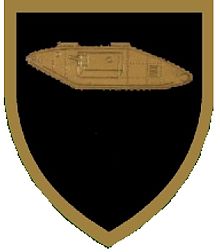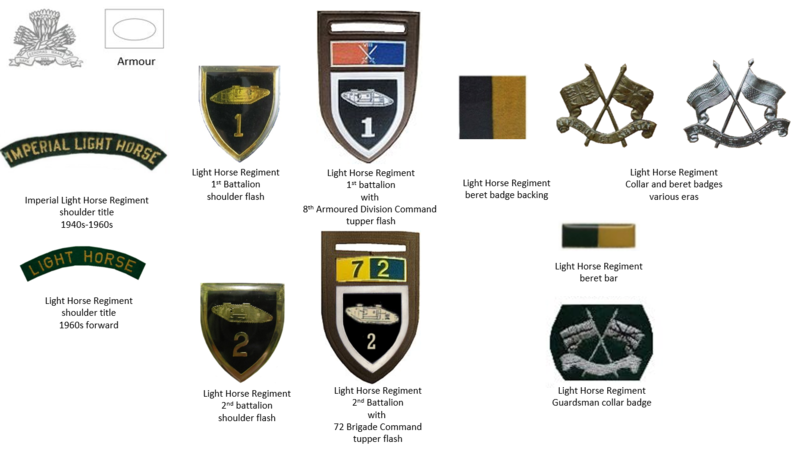

This article needs additional citations for verification. Please help improve this articlebyadding citations to reliable sources. Unsourced material may be challenged and removed.
Find sources: "Johannesburg Light Horse Regiment" – news · newspapers · books · scholar · JSTOR (January 2021) (Learn how and when to remove this message) |
| Imperial Light Horse Light Horse Regiment Johannesburg Light Horse Regiment | |
|---|---|

SANDF Light Horse Regiment emblem
| |
| Active | 21 September 1899 – present |
| Country | |
| Allegiance |
|
| Branch |
|
| Type | Armoured Car Regiment |
| Part of | South African Armoured Formation Army Conventional Reserve |
| Garrison/HQ | Mount Collins in Sandton, Johannesburg |
| Motto(s) | Patria et Libertas (Country and Liberty)[1] |
| Equipment | Eland APC, Rooikat |
| Insignia | |
| Abbreviation | JLHR |
| Beret Colour | Black |
| Armour Squadron emblems |  |
| Armour beret bar circa 1992 |  |
The Johannesburg Light Horse Regiment (JLHR, formerly the Light Horse Regiment, LHR), is a reserve armoured car reconnaissance unit of the South African Army.

The Imperial Light Horse was raised by the British in Johannesburg on 21 September 1899 for service in the Second Boer War. Its initial strength was 444 officers and men. It was informally known as the "Reformers Regiment" as many of its officers served on the Reform Committee, or more commonly the Uitlander Regiment by the Transvaal Government and the Boer Commandos.[1][2]
The Light Horse was engaged through much of the war and fought its first battle at Elandslaagte 21 October 1899, where its first colonel, John James Scott-Chisholme was killed leading from the front.[1][3][4] The Regiment was present at the Siege of Ladysmith (battle of Wagon Hill), Colenso, the Battle of Spion Kop (where they captured Commandant Hendrik Frederik Prinsloo, the commander of the Carolina Boer Commando[5]), and the Relief of Ladysmith.[1][3][6][7][8]
After the successful raising of the siege of Ladysmith the Light horse join the Mafeking Relief Column and were the first to enter the town on the night of 16/17 May 1900.[9]
In late 1900 a second battalion – the 2nd Imperial Light Horse was raised and embodied. Both battalions then went on to fight in the Transvaal and the Orange Free State Republic until the end of the war. In total the members of the Regiment won four Victoria Crosses during the war:[1]
In December 1902, the ILH was raised out of the Boer War unit of the same name.[10]: 60 Its first commanding officer was Lieutenant-Colonel J. Donaldson with adjutant Captain W. Jardine.[10]: 61 The regiment was reorganised into two wings and in 1904 its left wing was re-designated the Western Rifles at Krugersdorp, both as voluntary units in the Transvaal Volunteers.[1][11] In January 1905, the Prince of Wales became its first Colonel-in-Chief.[10]: 61 Lieutenant-Colonel W.T.F. Davies became its second commander in January 1906.[10]: 61
With the new amalgamation of the British colonies into the Union of South Africa in 1910 the separate colonial forces were combined into new organisations. The Regiment was re-designated as the 5th Mounted Rifles (Imperial Light Horse) on 1 July 1913 and transferred to the Active Citizen Force (the reserves) of the Union Defence Force.[1]
The Regiment took part in operations during World War I first in the South-West Africa Campaign in what is today Namibia[13] and afterwards in Egypt, Palestine and France.[1]
During the Interbellum the regiment was placed on the reserve but was briefly mobilised in 1922 to support the police during the Second Rand Revolt and fought in the Battle of Ellis Park.[1]

At the start of World War II the regiment was brought up to strength and a second battalion reconstituted as infantry battalions. However the two battalions were soon separated and fought different wars.[1]
The second battalion was soon re-designated as the 13th Armoured Car Company in the South African Tank Corps. The 13th was amalgamated with Royal Natal Carbineers to create the 6th Armoured Car Regiment and later that unit combined with the 4th Armoured Car Regiment to form the 4th/6th Armoured Car Regiment.[1]
The 1st Battalion joined the 3rd Brigade of the South African 1st Infantry Division and fought in the North African campaign and fought in the first and second battles of El Alamein.[1]
Returning to South Africa the 1st Battalion along with the 2nd were reorganised and amalgamated with the Kimberley Regiment to form the Imperial Light Horse/Kimberley Regiment. In September 1943 the regiment sailed for North Africa and joined the South African 6th Armoured Division in Egypt as a motorised battalion[1] under command of Colonel R. Reeves-Moore, DSO MC.[14] On 21 April 1944 the Regiment disembarked in Taranto as part of the 6th Armoured Division to join the British 8th Army in the Italian campaign.[15] The Regiment was assigned to the South African 12th Motorised Brigade which was detached from the 6th Armoured Division (which initially formed part of the reserves) and move up to Isernia and relieve the 11th Canadian Infantry Brigade in fighting in the mountains above Monte Cassino. They held these positions until after the fall of Monte Cassino and the breakout from the Anzio beachhead, when they withdrew and were reunited with the 6th Armoured Division.[1][16] The regiment then advanced with the 6th Division as part of the I Canadian Corps until they were north of Rome. The regiment entered Florence on 4 August 1944, then as part of the 11th South African Armoured Brigade.[1]
After a short period of rest and refitting, on 22 August 1944, the South African 6th Armoured Division was then placed under the command of the United States 5th Army. The army took part in the attack on the Gothic Line in which during heavy fighting around Monte Porro del Bagno almost a quarter of the Regiment were either killed or wounded before the breakthrough was achieved. The Regiment remained in the line and after breaching German defences at Bologna, the regiment fought its last large engagement at Finale south of Venice, after which the regimental band led the Allied victory parade at Monza on 14 May 1945.[1][15] The regiment remained in northern Italy for about three months before returning to South Africa in August 1945 where they were demobilised shortly after arriving back home.[1][17]
The regiment reformed in 1949 as an armoured regiment equipped with Sherman tanks in the Citizen Force.[1] In 1960 when South Africa left the Commonwealth and the Union became the Republic of South Africa the Regiment was symbolically retitled the Light Horse Regiment abandoning the inclusion of Imperial in its name.[1]
The Regiment, now equipped with armoured cars, prospered during the next 15 years reaching a strength of 2,000 by 1975 when it was split into two:
Both regiments saw action in the South African Border War (1966–1989) in Northern South-West Africa (now Namibia) and Angola, and were also involved in security operations policing the South Africa's townships in the late 1980s and early 1990s.[1]
After the country's first multiracial elections in 1994, following the Defence Review by the newly formed South African National Defence Force, in March 1997 the two battalions were amalgamated into Light Horse Regiment and designated an armoured reconnaissance regiment.[1]

In August 2019, 52 Reserve Force units had their names changed to reflect the diverse military history of South Africa.[18] The Light Horse Regiment became the Johannesburg Light Horse Regiment, and have 3 years to design and implement new regimental insignia.[19]
During the regiment's sixtieth anniversary celebrations in 1959, the Freedom of the Cities of Johannesburg, Mafeking and Ladysmith were awarded to it.[20]
The unit exercised its freedom of entry into Johannesburg on 9 November 2013 as part of the centenary celebrations of the City of Johannesburg with fixed bayonets, colours flying and drums beating.
The Regimental device for both headdress and collar dogs are a set of crossed flags mounted on lances. The flags are those of the RSA and the Regiment.


| From | Honorary Colonel | To |
| From | Officers Commanding | To |
| 1961 | Cmdt AJW Drysdale | c. 1965 |
| 1966 | Cmdt AR Nel | c. 1970 |
| 1971 | Cmdt RV Gibson | c. 1974 |
| 1974 | Cmdt RL Jackson | c. 1978 |
| 1978 | Cmdt M Finlay | c. 1982 |
| 1982 | Cmdt AD Thompson | c. 1983 |
| 1983 | Cmdt DM Bessenger | c. 1983 |
| 1983 | Cmdt JP Schuin | c. 1985 |
| 1985 | Cmdt IW Pearce | c. 1990 |
| 1990 | Cmdt GA Nel | c. 1993 |
| 1993 | Cmdt DJF Jacobs | c. 1993 |
| 1993 | Cmdt JF Els | c. 1993 |
| 1993 | Lt Col WJ Alberts | c. 2000 |
| 2000 | Lt Col HJ Marks | c. 2003 |
| 2003 | Lt Col J Martins | c. 2007 |
| 2007 | Lt Col HE Jansen | c. 2016 |
| 2017 | Lt Col ID Nkoana | 20 July 2024 |
| From | Regimental Sergeants Major | To |
| c. 1945 | WO1 WFE Dean | c. 1948 |
| c. 1948 | WO1 S de Lange | c. 1953 |
| c. 1953 | WO1 CJ Wessels | c. 1959 |
| c. 1959 | WO1 WJC Surmon | c. 1965 |
| c. 1965 | WO1 PJ Oosthuizen | c. 1975 |
| c. 1975 | WO1 R Morton | c. 1976 |
In total 31 battle honours have been awarded to 1 LHR and 2 LHR, 23 of which are currently displayed on the Regimental Colour:
The Battle Honours Elandslaagte and Relief of Mafeking, which the regiment had assumed, were disallowed when pre-Union battle honours were reviewed by the SA Defence Force in the 1960s.
| Awarded |
|---|
Tell England, ye who pass this Monument,
We, who died serving her, rest here content.[21]
|
| |||||||||||||||||||||||||||||||||||||||||||||||||||||||||||||||||
|---|---|---|---|---|---|---|---|---|---|---|---|---|---|---|---|---|---|---|---|---|---|---|---|---|---|---|---|---|---|---|---|---|---|---|---|---|---|---|---|---|---|---|---|---|---|---|---|---|---|---|---|---|---|---|---|---|---|---|---|---|---|---|---|---|---|
| |||||||||||||||||||||||||||||||||||||||||||||||||||||||||||||||||
| |||||||||||||||||||||||||||||||||||||||||||||||||||||||||||||||||
| |||||||||||||||||||||||||||||||||||||||||||||||||||||||||||||||||
| |||||||||||||||||||||||||||||||||||||||||||||||||||||||||||||||||
| |||||||||||||||||||||||||||||||||||||||||||||||||||||||||||||||||
| |||||||||||||||||||||||||||||||||||||||||||||||||||||||||||||||||
| |||||||||||||||||||||||||||||||||||||||||||||||||||||||||||||||||
| |||||||||||||||||||||||||||||||||||||||||||||||||||||||||||||||||
| |||||||||||||||||||||||||||||||||||||||||||||||||||||||||||||||||
| |||||||||||||||||||||||||||||||||||||||||||||||||||||||||||||||||
| |||||||||||||||||||||||||||||||||||||||||||||||||||||||||||||||||
| |||||||||||||||||||||||||||||||||||||||||||||||||||||||||||||||||
| |||||||||||||||||||||||||||||||||||||||||||||||||||||||||||||||||
| |||||||||||||||||||||||||||||||||||||||||||||||||||||||||||||||||
| |||||||||||||||||||||||||||||||||||||||||||||||||||||||||||||||||
| |||||||||||||||||||||||||||||||||||||||||||||||||||||||||||||||||